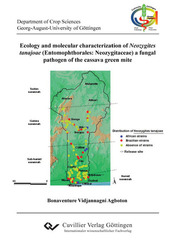| Fachbereiche | |
|---|---|
| Buchreihen (96) |
1378
|
| Nachhaltigkeit |
3
|
| Gesundheitswesen |
1
|
| Geisteswissenschaften |
2364
|
| Naturwissenschaften |
5406
|
| Mathematik | 229 |
| Informatik | 319 |
| Physik | 980 |
| Chemie | 1363 |
| Geowissenschaften | 131 |
| Humanmedizin | 243 |
| Zahn-, Mund- und Kieferheilkunde | 10 |
| Veterinärmedizin | 108 |
| Pharmazie | 147 |
| Biologie | 835 |
| Biochemie, Molekularbiologie, Gentechnologie | 121 |
| Biophysik | 25 |
| Ernährungs- und Haushaltswissenschaften | 45 |
| Land- und Agrarwissenschaften | 1004 |
| Forstwissenschaften | 201 |
| Gartenbauwissenschaft | 20 |
| Umweltforschung, Ökologie und Landespflege | 148 |
| Ingenieurwissenschaften |
1793
|
| Allgemein |
98
|
|
Leitlinien Unfallchirurgie
5. Auflage bestellen |
|
Erweiterte Suche
Ecology and molecular characterization of Neozygites tanajoae (Entomophthorales: Neozygitaceae) a fungal pathogen of the cassava green mite
Bonaventure Agboton (Autor)Vorschau
Inhaltsverzeichnis, Datei (40 KB)
Leseprobe, Datei (130 KB)
For the biological control of the cassava green mite (Mononychellus tanajoa, Bondar),
Brazilian strains of the entomopathogen Neozygites tanajoae were recently introduced into
Africa to improve the control achieved by predatory mites. In order to monitor the
establishment of the Brazilian strains two PCR primer pairs, NEOSSU_F / NEOSSU_R and
8DDC_F / 8DDC_R were tested on N. tanajoae strains collected from several locations in
Brazil and from three countries in Africa, Benin, Ghana and Tanzania. The first primer pair
enabled the species-specific detection of N. tanajoae, while the second differentiated the
Brazilian isolates from those of other geographical origin. The results confirmed that the two
primer pairs tested are suitable for the detection of N. tanajoae and the differential
identification of Brazilian and African strains. PCR can therefore be used to monitor the
establishment and spread of the Brazilian strains in Benin and in other African countries
where they have been introduced recently in order to improve cassava green mite (CGM)
control.
In this work the establishment and spread of Brazilian strains of N. tanajoae were followed
in a countrywide survey in Benin in which a total of 141 cassava fields were inspected.
Samples of M. tanajoa suspected of being infected by N. tanajoae were found in 60 fields
distributed between the coastal Southern Forest Mosaic (SFM) and the Northern Guinea
Savannah (NGS) zones. PCR analysis of DNA samples extracted from samples from these
fields revealed that N. tanajoae is well distributed in Benin and that Brazilian strains were
effectively established and have spread throughout the country. However, the highest rates of
infection due to Brazilian strains were observed in the sub-humid and humid savannah zones
of the country.
Identification of N. tanajoae strains using molecular tools, however, is very costly. Hence,
development of alternative techniques is desirable. Therefore, the difference in biocontrol
performance and in host ranges was compared to discriminate between African and Brazilian
strains of N. tanajoae. The results suggest that the biocontrol potential and the host ranges
bioassays are suitable for evaluating the infectiveness of N. tanajoae on cassava green mite.
However, those methods were not suitable for differentiating among different origins of
strains of the entomopathogenic fungus.
The establishment of N. tanajoae in Benin after its introduction for the control of cassava
green mite resulted in co-occurrence with the predatory mite Typhlodromalus aripo in cassava
fields. However, little is known on the interaction of the two antagonists and on the biological
control potential of M. tanajoa. In a series of greenhouse experiments, effects of single and
combined releases of N. tanajoae and T. aripo on their respective population dynamics and on
the suppression of M. tanajoa populations were evaluated. In order to complement the
greenhouse experiments, laboratory experiments were conducted to evaluate the feeding,
oviposition and longevity of T. aripo fed with healthy or N. tanajoae-infected M. tanajoa. The
results showed that simultaneous release of T. aripo and N. tanajoae in the same cassava field
may be detrimental to the biological control of the cassava green mite. It is therefore
preferable to release in each area only the antagonist species known to be well adapted to the
prevailing environmental conditions.
In conclusion, this thesis shows that molecular techniques are the most suitable methods to
detect infection of CGM by N. tanajoae and to differentiate among strains. Molecular
techniques are also useful for monitoring the establishment and dispersal of introduced N.
tanajoae species in the field. Furthermore, this study increased our knowledge on the
performance and host ranges of the African and Brazilian strains of N. tanajoae. It also
improves our understanding of the interaction between N. tanajoae and the most effective
predatory mite T. aripo as both biocontrol agents are sharing the same habitats.
Future research should focus on in vitro production and cryopreservation of African strains
of N. tanajoae in order to develop specific primers for detecting African isolates.
Furthermore, studies of the genetic diversity of N. tanajoae populations in the cassava fields
using molecular techniques could strongly improve our understanding of the interaction
between exotic and native fungi in the cassava ecosystem. Further investigations are required
on the interaction between the predatory mite T.aripo and the pathogen N. tanajoae at a larger
spatial scale and under natural conditions, and on factors affecting the loss in biocontrol
potential of exotic species of N. tanajoae when introduced in their new environment.
| ISBN-13 (Printausgabe) | 3867279233 |
| ISBN-13 (Printausgabe) | 9783867279239 |
| ISBN-13 (E-Book) | 9783736929234 |
| Sprache | Englisch |
| Seitenanzahl | 102 |
| Auflage | 1 Aufl. |
| Band | 0 |
| Erscheinungsort | Göttingen |
| Promotionsort | Universität Göttingen |
| Erscheinungsdatum | 19.03.2009 |
| Allgemeine Einordnung | Dissertation |
| Fachbereiche |
Land- und Agrarwissenschaften
|








